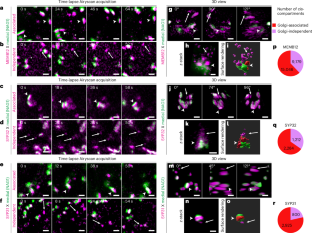ER-to-Golgi trafficking through a dynamic intermediate cis-Golgi tubular network in Arabidopsis
IF 17.3
1区 生物学
Q1 CELL BIOLOGY
引用次数: 0
Abstract
Endoplasmic reticulum (ER)-to-Golgi trafficking is a central process of the secretory system of eukaryotic cells that ensures proper spatiotemporal sorting of proteins and lipids. However, the nature of the ER–Golgi intermediate compartments (ERGICs) and the molecular mechanisms mediating the transition between ERGICs and the Golgi, as well as the universality of these processes among eukaryotes, remain undiscovered. Here we identify a reticulated tubulo-vesicular network, labelled by MEMBRIN proteins, that is mostly independent of the Golgi, highly dynamic at the ER–Golgi interface and crossed by ER-induced released luminal cargos. We find that plant ERGICs become stabilized by the interaction they establish with pre-existing Golgi and gradually mature into Golgi cisternae, this process being dependent on C24-ceramide sphingolipids. Our study is a major twist in the understanding of the Golgi, as it identifies that the ERGICs in plants comprise a Golgi-independent and highly dynamic tubular network from which arise more stable Golgi-associated pre-cisternae structures. Fougère, Grison et al. show that the ER–Golgi intermediate compartment (ERGIC) in plants is a tubulo-vesicular network marked by MEMBRIN proteins that is largely Golgi-independent. The plant ERGIC matures into Golgi cisternae, in a process that depends on sphingolipids.


求助全文
约1分钟内获得全文
求助全文
来源期刊

Nature Cell Biology
生物-细胞生物学
CiteScore
28.40
自引率
0.90%
发文量
219
审稿时长
3 months
期刊介绍:
Nature Cell Biology, a prestigious journal, upholds a commitment to publishing papers of the highest quality across all areas of cell biology, with a particular focus on elucidating mechanisms underlying fundamental cell biological processes. The journal's broad scope encompasses various areas of interest, including but not limited to:
-Autophagy
-Cancer biology
-Cell adhesion and migration
-Cell cycle and growth
-Cell death
-Chromatin and epigenetics
-Cytoskeletal dynamics
-Developmental biology
-DNA replication and repair
-Mechanisms of human disease
-Mechanobiology
-Membrane traffic and dynamics
-Metabolism
-Nuclear organization and dynamics
-Organelle biology
-Proteolysis and quality control
-RNA biology
-Signal transduction
-Stem cell biology
 求助内容:
求助内容: 应助结果提醒方式:
应助结果提醒方式:


